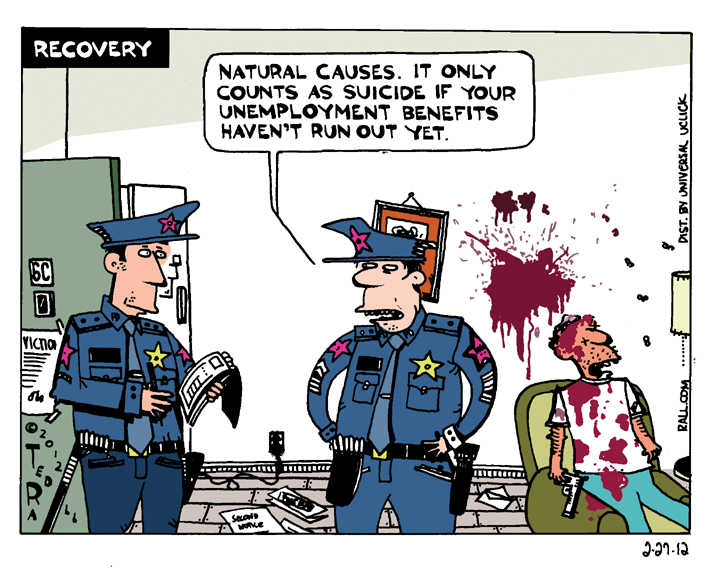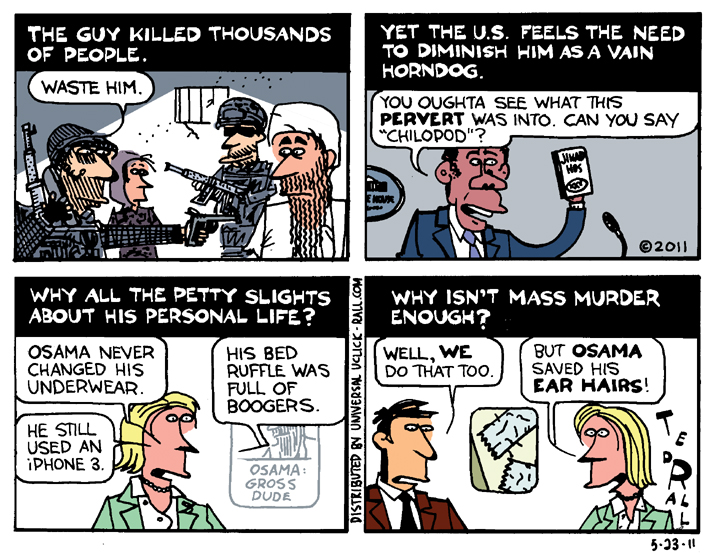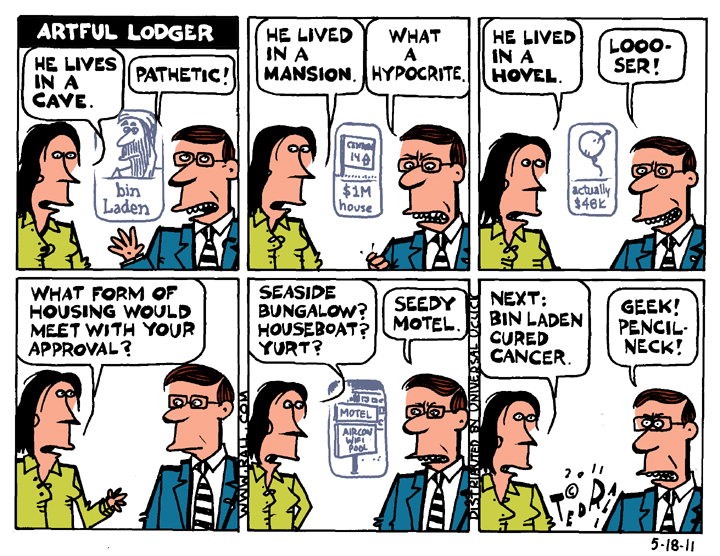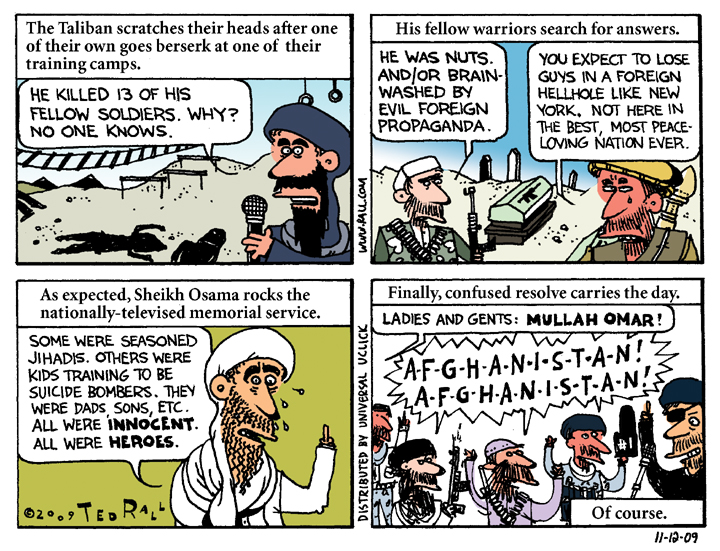The government claims that unemployment is dropping, but that’s only because long-term unemployed Americans no longer count.
SYNDICATED COLUMN: American Dogs Count More Than Afghan People
Helicopter Shootdown Story Unmasks Bigoted Media
New York Times war correspondent Dexter Filkins couldn’t help liking the young American soldiers with whom he was embedded in U.S.-occupied Iraq. Recognizing that, Filkins tried to maintain some professional distance. “There wasn’t any point in sentimentalizing the kids; they were trained killers, after all. They could hit a guy at five hundred yards or cut his throat from ear-to-ear. They had faith, they did what they were told and they killed people,” he wrote in his book of war vignettes, “The Forever War.”
Alas, he was all but alone.
All wars demand contempt for The Other. But the leaders of a country waging a war of naked, unprovoked aggression are forced to rely on an even higher level of enemy dehumanization than average in order to maintain political support for the sacrifices they require. Your nation’s dead soldiers are glorious heroes fallen to protect hearth and home. Their dead soldiers are criminals and monsters. Their civilians are insects, unworthy of notice. So it is. So it always shall be in the endless battle over hearts and minds.
Even by these grotesque, inhuman rhetorical standards, the ten-year occupation of Afghanistan has been notable for the hyperbole relied upon by America’s compliant media as well as its brazen inconsistency.
U.S. and NATO officials overseeing the occupation of Afghanistan liken their mission to those of peacekeepers—they’re there to help. “Protecting the people is the mission,” reads the first line of the International Security Assistance Force (ISAF) Commander’s Counterinsurgency Guidance statement. “The conflict will be won by persuading the population, not by destroying the enemy. ISAF will succeed when the [Karzai government] earns the support of the people.”
Of course, actions speak louder than words. Since 2001 ISAF has been doing precious little protecting of anything other than America’s geopolitical interests, using Afghanistan as a staging ground for thousands of drone attacks across the border in Pakistan. Protecting Afghanistan civilians has actually been a low ISAF priority, to say the least. They’ve been bombing civilians indiscriminately, then lying about it, sometimes paying off bereaved family members with token sums of blood money.
The verbiage deployed by American officials, dutifully transcribed by journo-stenographers at official press briefings, sends nearly as loud a message as a laser-guided Hellfire missile slamming into a wedding party: Afghan lives mean nothing.
The life of an American dog—literally, as we’ll see below—counts more than that of an Afghan man or woman.
In the worst single-day loss of life for U.S. forces in Afghanistan, Taliban fighters shot down a Chinook CH-47 transport helicopter in eastern Wardak province with a rocket-propelled grenade on August 6th.
(I lifted that “worst single-day loss of life” phrase from numerous press accounts. The implication is obvious—the U.S. isn’t accustomed to taking losses. But tens of thousands of Afghans, possibly hundreds of thousands, have been killed in the war that began in 2001.)
Western media’s attitude toward the Afghans they are supposedly trying to “assist” was as plain as the headlines. “U.S. Troops, SEALs Killed in Afghanistan Copter Crash,” reported Time magazine. (SEALS are U.S. Navy commandos.) “31 Killed in Afghanistan Chopper Crash,” said the ABC television network. “31 Dead in Afghanistan Helicopter Crash,” shouted Canada’s National Post. (The number was later revised to 30.)
Eight Afghan government commandos died too. But dead Afghans don’t rate a headline—even when they’re working for your country’s puppet regime. As far as the American press is concerned, only 30 people—i.e., Americans—died.
An initial Associated Press wire service report noted that the dead included “22 SEALs, three Air Force air controllers, seven Afghan Army troops, a dog and his handler, and a civilian interpreter, plus the helicopter crew.”
The dog. They mentioned the dog.
And the dog’s handler.
After 9/11 American pundits debated the question: Why do they [radical Muslims] hate us [Americans] so much? This is why. It is official Pentagon policy not to count Afghan or Iraqi or Pakistani or Libyan or Yemeni or Somali dead, civilian or “enemy.” But “our” guys are sacred. We even count our dogs.
Lest you think that I’m exaggerating, that this was merely another example of a reporters larding his account with excessive detail, consider this maudlin missive by Michael Daly of the New York Daily News, one of the biggest newspapers in the United States:
“Among the SEALs were a dog handler and a dog that would remind outsiders of Cujo [a rabies-infected beast in one of Stephen King’s horror novels], but held a special place in the hearts of the squadron,” wrote Daly. “SEALs have a soft spot for their dogs, perhaps partly because a canine’s keen senses can alert them to danger and give them a critical edge. A dog also allows resolutely reticent warriors to express a little affection; you can pet a pooch, if not another SEAL.”
Get a grip, Mike. Lots of people like dogs.
“Many of the SEALs have a dog stateside,” continueth Daly. “To take one on a mission may be like bringing along something of home.”
Or maybe they just come in handy for Abu Ghraib-style interrogations.
Daly tortures and twists his cheesy prose into the kind of savage propaganda that prolongs a war the U.S. can’t win, that is killing Afghans and Americans for no reason, that most Americans prefer not to think about. Soon a group of elite commandos—members of Team Six, the same outfit that assassinated Osama bin Laden—become helpless victims of the all-seeing, all-powerful Taliban of Death. In Daly’s bizarre world, it is the Afghan resistance forces and their 1980s-vintage weapons that have all the advantages.
Note the infantile use of the phrase “bad guys.”
“The bad guys knew when the Chinook helicopter swooped down into an Afghan valley that it would have to rise once those aboard were done. All the Taliban needed to do was wait on a mountainside. The Chinook rose with a SEAL contingent that likely could have held off thousands of the enemy on the ground. The SEALs could do nothing in the air against an insurgent with a rocket.”
Helpless! One could almost forget whose country these Americans were in.
Or what they were in Wardak to do.
Early reports had the dead Navy SEALs on a noble “rescue mission” to “assist” beleaguered Army Rangers trapped under “insurgent” fire. Actually, Team Six was on an assassination assignment.
“The American commandos who died when their helicopter crashed in eastern Afghanistan were targeting a Taliban commander directly responsible for attacks on U.S. troops,” CNN television reported on August 7th. “Targeting” is mediaspeak for “killing.” According to some accounts they had just shot eight Talibs in a house in the village of Jaw-e-Mekh Zareen in the Tangi Valley. Hard to imagine, but U.S. soldiers used to try to capture enemy soldiers before killing them.
Within hours newspaper websites, radio and television outlets were choked with profiles of the dead assassins—er, heroes.
The AP described a dead SEAL from North Carolina as “physically slight but ever ready to take on a challenge.”
NBC News informed viewers that a SEAL from Connecticut had been “an accomplished mountaineer, skier, pilot and triathlete and wanted to return to graduate school and become an astronaut.”
What of the Afghans killed by those SEALs? What of their hopes and dreams? Americans will never know.
Two words kept coming up:
Poignant.
Tragedy (and tragic).
The usage was strange, outside of normal context, and revealing.
“Of the 30 Americans killed, 22 were members of an elite Navy SEAL team, something particularly poignant given it was Navy SEALS who succeeded so dramatically in the raid that killed Osama bin Laden,” said Renee Montaigne of National Public Radio, a center-right outlet that frequently draws fire from the far right for being too liberal.
Ironic, perhaps. But hardly poignant. Soldiers die by the sword. Ask them. They’ll tell you.
Even men of the cloth wallowed in the bloodthirsty militarism that has obsessed Americans since the September 11th attacks. Catholic News Service quoted Archbishop Timothy P. Broglio, who called the Chinook downing a “reminder of the terrible tragedy of war and its toll on all people.”
“No person of good will is left unmoved by this loss,” said the archbishop.
The Taliban, their supporters, and not a few random Afghans, may perhaps disagree.
This is a war, after all. Is it too much to ask the media to acknowledge the simple fact that some citizens of a nation under military occupation often choose to resist? That Americans might take up arms if things were the other way around, with Afghan occupation forces bombing and killing and torturing willy-nilly? That one side’s “insurgents” and “guerillas” are another’s patriots and freedom fighters?
Don’t news consumers have the right to hear from the “other” side of the story? Or must we continue the childish pretense that the Taliban are all women-hating fanatics incapable of rational thought while the men (and dog) who died on that Chinook in Wardak were all benevolent and pure of heart?
During America’s war in Vietnam reporters derided the “five o’clock follies,” daily press briefings that increasingly focused on body counts. Evening news broadcasts featured business-report-style graphics of the North and South Vietnamese flags; indeed, they immediately followed the stock market summary. “The Dow Jones Industrial Average was down 16 points in light trading,” Walter Cronkite would intone. “And in Vietnam today, 8 Americans were killed, 18 South Vietnamese, 43 Vietcong.”
Like the color-coded “threat assessment levels” issued by the Department of Homeland Security after 2001, the body counts became a national joke.
In many ways America’s next major conflict, the 1991 Gulf War, was a political reaction to the Vietnam experience. Conscription had been replaced by a professional army composed of de facto mercenaries recruited from the underclass. Overkill supplanted the war for hearts and minds that defined the late-Vietnam counterinsurgency strategy. And reporters who had enjoyed near total freedom in the 1960s were frozen out. Only a few trusted journos were allowed to travel with American forces in Kuwait and Iraq. They relied on the Pentagon to transmit their stories back home; one wire service reporter got back home to find that the military had blocked every single account he had filed.
Citing the five o’clock follies of Vietnam and declaring themselves incapable of counting civilian or enemy casualties, U.S. military officials said they would no longer bother to try. (Covertly, the bureaucracy continued to try to gather such data for internal use.)
Meanwhile, media organizations made excuses for not doing their jobs.
The UK Guardian, actually one of the better (i.e. not as bad) Western media outlets, summarized the mainstream view in August 2010: “While we are pretty good at providing detailed statistical breakdowns of coalition military casualties (and by we, I mean the media as a whole), we’ve not so good at providing any kind of breakdown of Afghan civilian casualties…Obviously, collecting accurate statistics in one of the most dangerous countries in the world is difficult. But the paucity of reliable data on this means that one of the key measures of the war has been missing from almost all reporting. You’ve noticed it too—asking us why we publish military deaths but not civilian casualties.”
No doubt, war zones are dangerous. According to Freedom Forum, 63 reporters lost their lives in Vietnam between 1955 and 1973—yet they strived to bring the war home to homes in the United States and other countries. And they didn’t just report military deaths.
There’s something more than a little twisted about media accounts that portray a helicopter shootdown as a “tragedy.”
A baby dies in a fire—that’s a tragedy. A young person struck down by some disease—that’s also a tragedy. Soldiers killed in war? Depending on your point of view, it can be sad. It can be unfortunate. It can suck. But it’s not tragic.
Alternately: If the United States’ losses in Afghanistan are “tragedies,” so are the Taliban’s. They can’t have it both ways.
“Tragedy Devastates Special Warfare Community,” blared a headline in USA Today. You’d almost have to laugh at the over-the-top cheesiness, the self-evident schmaltz, the crass appeal to vacuous emotionalism, in such ridiculous linguistic contortions. That is, if it didn’t describe something truly tragic—the death and mayhem that accompanies a pointless and illegal war.
On August 10th the U.S. military reported that they had killed the exact Talib who fired the RPG that brought down the Chinook. “Military officials said they tracked the insurgents after the attack, but wouldn’t clarify how they knew they had killed the man who had fired the fatal shot,” reported The Wall Street Journal.
“The conflict will be won by persuading the population, not by destroying the enemy.” But destroying the enemy is more fun.
(Ted Rall is the author of “The Anti-American Manifesto.” His website is tedrall.com.)
COPYRIGHT 2011 TED RALL
SYNDICATED COLUMN: Osama bin Laden’s Ultimate Victory
Culturally Clueless and Politically Tonedeaf, U.S. Gave Bin Laden the Martyrdom He Craved
The assassination of Osama bin Laden was masterfully orchestrated to appeal to American media consumers. But it will play poorly overseas.
President Obama’s Sunday evening announcement, timed to fill Monday’s papers with a sickening orgy of gleeful triumph but little information, prompted bipartisan high-fives and hoots all around. “U-S-A! U-S-A!” chanted a mob of drunken oafs in front of the White House. Blending the low satire of two Bush-era classic send-ups of a nation allergic to self-reflection, “Team America: World Police” and “Idiocracy,” they set the tone for a week or a month or whatever of troop-praising, God-blessing-America, frat-boy self-backslapping. “So that’s what success looks like,” wrote New York Times TV critic Alessandra Stanley in the paper’s special ten-page “The Death of Bin Laden” pull-out section.
Success for Obama, certainly. He’ll see a much-needed bump in the polls. But it won’t last. Eventually the unemployed will wonder why the president devotes so many resources to killing one man but so little to them.
On the geopolitical front, the CIA’s ballyhooed Bin Laden takedown operation couldn’t possibly have been handled any worse. The War on Terror, if it ever existed, is a war for the hearts and minds of hundreds of millions of Muslims.
Remember?
It’s about them. Not us.
“Bin Laden wanted to die as a martyr. In this sense, his wish was obliged,” notes Stephen Diamond in Psychology Today.
You betcha.
Nothing was more important to Osama than to be seen as a brave soldier in an epic clash of civilizations. Claims that he hardly saw combat during the anti-Soviet resistance of the 1980s hurt him. The soft son of a Saudi billionaire and a former mother’s boy, Osama wanted to prove himself.
This past weekend, thanks to Navy Seals, he did. He went out in a blaze of glory, like Scarface. His status as a martyr, as a legend of jihad, is assured.
Yet another screw-up for the U.S., which fell into Bin Laden’s trap after 9/11. To Al Qaeda and other Islamist groups, the United States and the West is enemy #2. Their biggest foe is pro-American Muslim dictators and autocrats, and the apathy and indifference among Muslims that allows them to remain in power.
As with most actions carried out by small terrorist groups against enemies with superior manpower and weaponry, the operations attributed to Bin Laden—the bombings of the U.S. embassies in east Africa in 1998 and the U.S.S. Cole in 2000, and 9/11—were intended to provoke the U.S. into overreacting, thus exposing it as the monster he said it was. The invasions of two Muslim countries, Guantánamo, torture, Abu Ghraib, the secret prisons and disappearances and all the rest neatly fit into Osama Bin Laden’s narrative, proving his point more succinctly than a zillion fatwas faxed into Al Jazeera.
Everything about Bin Laden’s killing squares with the jihadi narrative.
The operation violated the sovereignty of a Muslim country, a constant complaint of radical jihadis. Armed commandos lawlessly invaded Pakistan. Infidel soldiers shot up a house and crashed a helicopter down the street from a military academy. Pakistanis see American drone planes buzzing around overhead, invading their airspace without the thinnest veneer of legality; American missiles blow up houses indiscriminately. Taking out Bin Laden without asking Pakistan’s government for permission is an act of war to which the country’s poverty permits no response. It’s yet another humiliation, another triumph of might over right.
Much will be made of the disrespectful treatment of Bin Laden’s body.
In an echo of Bush’s selection of Guantánamo as a extraterritorial not-U.S.-not-foreign no man’s land, the Obama Administration claimed that it buried Bin Laden at sea because it couldn’t find a country to accept his body within the required 24 hours after death, and to avoid the possibility that his grave would become a shrine for Muslim extremists. However, Bin Laden’s Wahhabi sect of Islam allows neither shrines nor burial at sea.
Of course, few Americans care about respecting Muslim religious sensibilities. So this decision went over well in the States. Countless editorial cartoons depicted sharks feasting on the carcass of the Bogeyman of the Twin Towers.
But it will inflame Muslim purists. Worse than that, dumping Osama into the Indian Ocean feeds an image the United States would be smart to shake, of a superpower hell-bent on occupying Muslim lands, stealing their oil and trashing their religion.
On the hearts-and-minds front, Americans’ chest-thumping is a PR disaster.
“Rot in Hell,” blared the headline of the New York Daily News. “Justice has been done,” pundits and politicians claimed—a strange endorsement of extrajudicial assassination by a nation based on the rule of law.
“Triumphalism and unapologetic patriotism are in order,” wrote Eugene Robinson for The Washington Post. “We got the son of a bitch.”
Classy.
Islam teaches combatants to respect their enemies. The death of an opponent is tragic, sometimes a tragic necessity, but never trivial, never a subject for joking. A vanquished enemy should be dispatched quickly, presumably to be chastised by Allah for his wickedness in the afterlife, but he is never to be mocked. A Muslim should not enjoy war or combat, nor gloat when victorious. When the powerful crush the weak, as was the case with the U.S. killing of Bin Laden, dancing around like a beefy hunk of steroids spiking the football at the touchdown line makes one look small.
It also makes us look dumb. As anyone not drunk on bloodlust knows, the worst thing that could have happened to Osama Bin Laden would have been arrest followed by a fair trial.
(Ted Rall is the author of “The Anti-American Manifesto.” His website is tedrall.com.)
COPYRIGHT 2011 TED RALL
A Lesson Is Learned
We seriously need to retire words like “hero” and phrases like “my heart goes out to _____.” The Fort Hood victims were that–victims. We’ve devalued the word “hero” to the point that it is now meaningless.
This week’s cartoon was inspired by watching the unbearably cheesy pep rally masquerading as a memorial service at Fort Hood yesterday.






